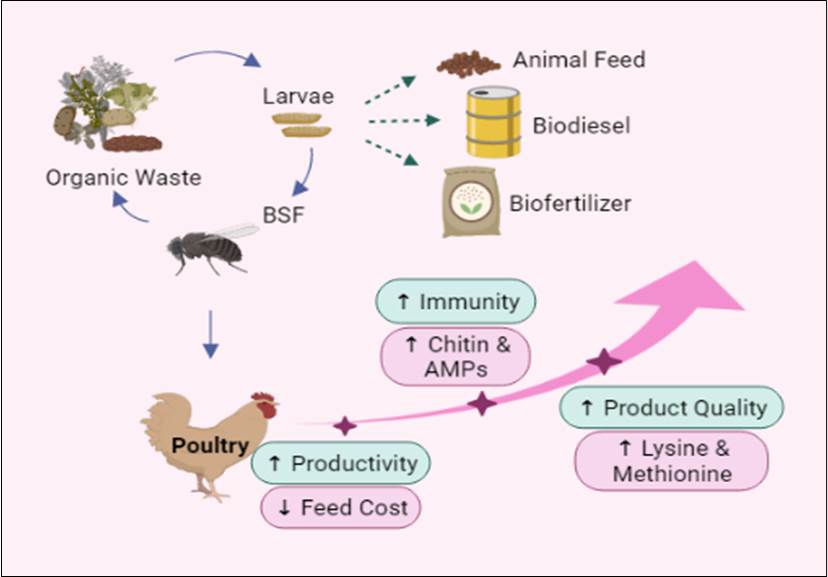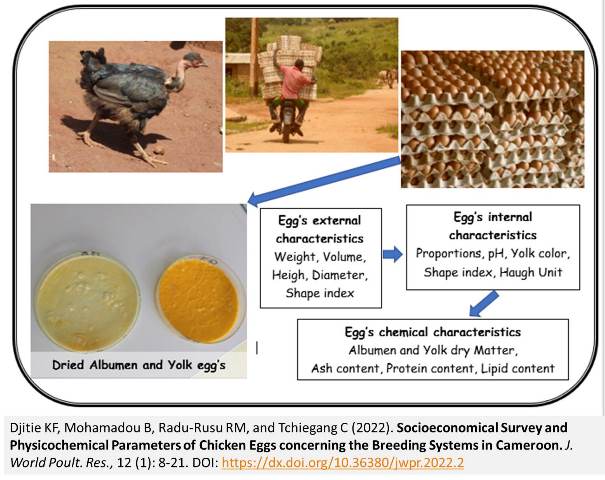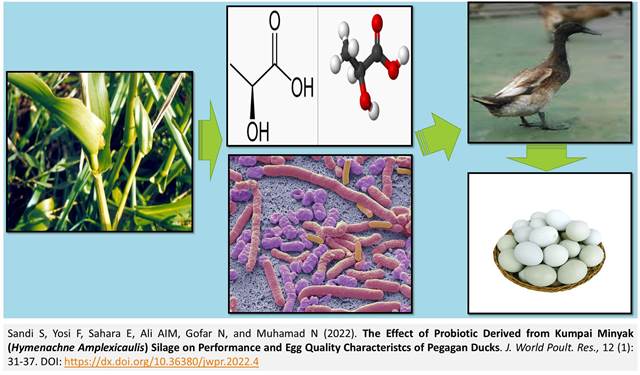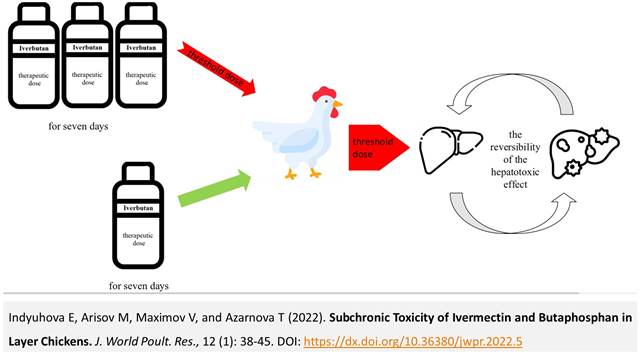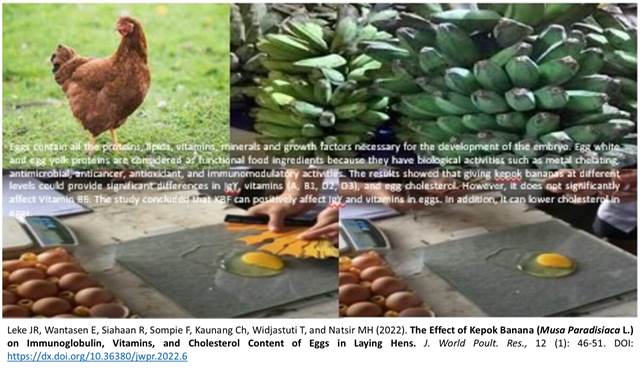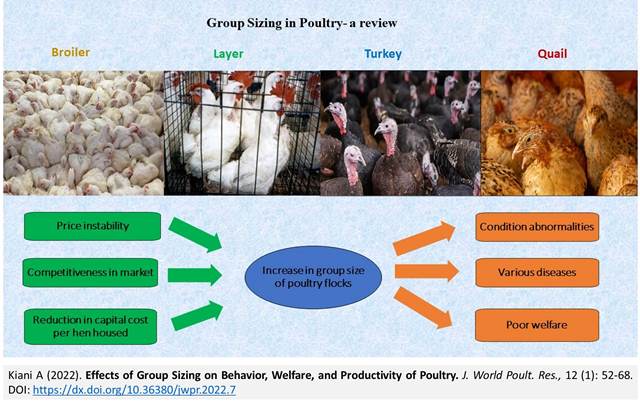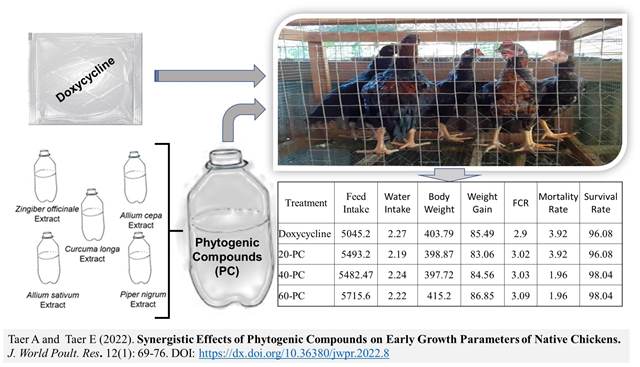Previous issue | Next issue | Archive
Volume 12 (1); March 25, 2022 [Booklet] [Endnote XML for Agris]
Nutritive Value of Black Soldier Fly (Hermetia illucens) as Economical and Alternative Feedstuff for Poultry Diet
Ali Shah SR and Çetingül IS.
J. World Poult. Res. 12(1): 01-07, 2022; pii: S2322455X2200001-12
DOI: https://dx.doi.org/10.36380/jwpr.2022.1
ABSTRACT: Recently, insects have gained importance as viable protein-rich feedstuff with better productivity and feed efficiency for livestock and pet animal feeds. The most potential species are the black soldier fly (Hermetia illucens), yellow mealworm (Tenebrio molitor), and common house fly (Musca domestica). Amongst these insects, the black soldier fly (Hermetia illucens) contains high protein and fat with the amino acid profile in H. illucens larvae equivalent to that of various protein-rich feedstuffs, such as fish meal and soybean meal. This review aimed to illustrate the reputation of black soldier fly larva meal as a substitute to conservative, expensive, and ecologically threatening crops by guaranteeing a productive, inexpensive, organic, and perpetual source of non-conventional protein feedstuff for poultry production of broilers and layers. It can be concluded that the black soldier fly sometimes has very similar and significant effects on the productivity, health, and product quality of birds, compared to soybean and fishmeal.
Keywords: Black soldier fly, Nutritive potential, Productivity
[Full text-PDF] [Scopus] [Export from ePrint] [How to Cite]
Research Paper
Socioeconomical Survey and Physicochemical Parameters of Chicken Eggs concerning the Breeding Systems in Cameroon
Djitie KF, Mohamadou B, Radu-Rusu RM, and Tchiegang C.
J. World Poult. Res. 12(1): 8-21, 2022; pii: S2322455X2200002-12
DOI: https://dx.doi.org/10.36380/jwpr.2022.2
ABSTRACT: Physicochemical characteristics of eggs are still poorly controlled in poultry farming in the city of Ngaoundéré, Cameroon. The present study was thus conducted to characterize the rearing systems in modern poultry farming and to analyze the physicochemical characteristics of eggs from hens reared in deep litter, battery, and backyard systems from August to October 2020 in Ngaoundéré, Cameroon. To this end, 33 farms with approximately 61100 hens (Cobb500 broiler and layer) were surveyed. At the end of this survey, a sample of 180 eggs was collected, with 60 eggs per system for physicochemical analyses. Data included socio-economic and technical characteristics of modern farming systems as well as the physicochemical parameters of the eggs. The obtained results indicated that 90.9% of Cobb500 chicken owners were men. Of the total of the layer’s buildings, 73% were equipped with nests. The materials used for feeders were made of wood (54.4%), plastic (21.2%), or cement (6.1%). Moreover, 81.1% of the poultry farmers buy chicken feed on the market while the others prepare their own feed from various ingredients. Preventive and curative prophylactic measures were applied by all livestock farmers, yet 54. 5% were still victims of different diseases. The selling price of a 45-day-old broiler chicken was between 4 and 6 USD, while the price of a 30-egg tray varied between 3 and 4 USD, which contributed to 60-80% of family income for 54.5% of poultry farmers. The high feed cost as well as lack of finance, ingredients, and security were the main issues of poultry farming. Concerning the physicochemical characteristics of eggs, a significant increase in egg weight was noted among backyard (43.50 ± 3.15 g), battery (58.19 ± 4.02 g), and deep litter (63.51 ± 3.91 g) systems. The Haugh’s Unit of eggs in the backyard system (72.33 ± 4.42%) was significantly lower than deep litter (82.91 ± 6.76%) and battery systems (86.83 ± 11.42%). The proportions of eggshell and edible contents were similar in all production systems. Yolk lipid (17.63%) and yolk protein (7.11%) in dry matter contents of local breed eggs were higher than those of improved breed from both systems. The findings indicated that modern poultry farming in Ngaoundéré has been poorly developed and backyard eggs were richer in nutrients and consequently highly recommended to use.
Keywords: Breeding Systems, Egg Characteristics, Chicken, Socio-economic survey
[Full text-PDF] [Scopus] [Export from ePrint] [How to Cite]
Research Paper
The Effect of Artemisia on Immune Response and Productive Performance Against Newcastle Disease in Broiler Chickens
Kaab HT, Hameed SS, and Sahib AM.
J. World Poult. Res. 12(1): 22-30, 2022; pii: S2322455X2200003-12
DOI: https://dx.doi.org/10.36380/jwpr.2022.3
ABSTRACT: Prevention of Newcastle disease has received a lot of interest across the world. The high productivity performance of the commercial chickens’ breeds has negative effects on the immune system and animal welfare. As a result, the current study aimed to investigate the benefits of adding Artemisia powder at levels of 0.5% and 1% to broilers’ feed as a growth and health promoter. A total of 120 commercial broiler chickens were grown on the floor in a chicken house and separated into three groups, including one control and two treatment groups. Each group contained 40 chickens subdivided into two replicates. The three groups, namely G1 (chickens without Artemisia powder, as a control group), G2, and G3 in which chickens were fed with basal diet plus 0.5% and 1% Artemisia powder, respectively, were differentiated based on their diet throughout 35 days of the experiment. The measured parameters included the immune response to Newcastle disease vaccine, blood biochemical parameters, and growth performance as well as relative weight for the spleen and bursa of Fabricius. A diet containing 1% Artemisia powder significantly improved antibody titer against Newcastle disease, body weight, and weight gain. Thus, the addition of 1% of Artemisia powder to the broiler’s diet can improve immune response against Newcastle disease and growth performance.
Keywords: Artemisia, Broiler chicken, Newcastle disease, Productive traits
[Full text-PDF] [Scopus] [Export from ePrint] [How to Cite]
| The Effect of Probiotic Derived from Kumpai Minyak (Hymenachne Amplexicaulis) Silage on Performance and Egg Quality Characteristcs of Pegagan Ducks |
Research Paper
The Effect of Probiotic Derived from Kumpai Minyak (Hymenachne Amplexicaulis) Silage on Performance and Egg Quality Characteristcs of Pegagan Ducks
Sandi S, Yosi F, Sahara E, Ali AIM, Gofar N, and Muhamad N.
J. World Poult. Res. 12(1): 31-37, 2022; pii: S2322455X2200004-12
DOI: https://dx.doi.org/10.36380/jwpr.2022.4
ABSTRACT: The study aimed to determine the effect of probiotics derived from an isolate of silage Kumpai Minyak grass on performance and the physical egg quality of Pegagan ducks. The study was conducted in 16 weeks, from May to September 2020. The sample size was 400 female Pegagan ducks aged five months. The treatments included basal diet (Control) and base diet plus 0.2% (P2), 0.4% (P4), 0.6% (P6), and 0.8% (P8) probiotic silage of Kumpai Minyak grass. The observed variables were performance (egg production, egg weight, feed consumption, and feed conversion ratio) and physical quality (albumen index, albumen weight, yolk weight, and Haugh unit). Observation data on probiotic treatment 0.8% (P8) established a significant effect on egg weight, compared to other treatments. Moreover, P8 probiotic treatment could significantly affect daily egg production and feed conversion ratio, compared to P2 and P4 probiotic treatments. Different results were found in the observations on feed consumption, where the overall treatment diet indicated significant results, compared to the control treatment. Specifically, several variables showed a significant effect, namely albumen index, albumen weight, egg yolk weight, and Haugh unit. Each observed variable value increased along with increasing probiotic treatment levels. However, egg index, egg yolk index, shell weight, and thickness were inversely related to the other variables investigated in this study. The P8 probiotic treatment could increase digestibility and absorption of feed nutrients due to inhibition of pathogenic bacteria and optimization of the digestive tract. The probiotics at the level of 0.8% produced from the Kumpai grass silage process can be used as a growth promoter for laying ducks to replace commercial antibiotic products.
Keywords: Albumen, Antibiotic, Growth promoter, Isolate, Probiotic, Silage
[Full text-PDF] [Scopus] [Export from ePrint] [How to Cite]
| Subchronic Toxicity of Ivermectin and Butaphosphan in Layer Chickens |
Research Paper
Subchronic Toxicity of Ivermectin and Butaphosphan in Layer Chickens
Indyuhova E, Arisov M, Maximov V, and Azarnova T.
J. World Poult. Res. 12(1): 38-45, 2022; pii: S2322455X2200005-12
DOI: https://dx.doi.org/10.36380/jwpr.2022.5
ABSTRACT: The development of new veterinary drugs to treat and prevent poultry parasitic infections, as well as the study of their safety is a hot topic for modern parasitology. The purpose of this research was to study the subchronic toxicity of the ivermectin and butaphosphan-based drugs at a therapeutic and threefold therapeutic dose during a seven-day oral administration to the Hisex White chickens. The provisional name of the drug is Iverbutan. The chickens from the first experimental group were given the drug at a threefold therapeutic dose of 3 mL of the drug per one liter of drinking water. The chickens from the second experimental group were given the drug at a therapeutic dose of 1 mL of Iverbutan per one liter of drinking water. The chickens from the control group received water without the drug. The chickens were weighed, and then the body temperature and blood samples from the axillary vein were measured on days 1, 8, and 17 of the experiment before the morning feeding. On day 8 of the study, the chickens from the first experimental group showed a 7.4% decrease in body weight and increase in body temperature by 0.8%, an increase in alanine aminotransferase activity by 2.1 times, aspartate aminotransferase activity by 1.6 times, and bile acids by 1.4 times. Moreover, there was a 4.6% decrease in glucose concentration, a 3.5% increase in lactate dehydrogenase activity, a 7.3% decrease in triglycerides, as well as a decrease in hemoglobin by 3.2% and erythrocytes by 10.6% in the first experimental group, compared to the control group. On day 17 of the experiment, the above blood parameters in the chickens from the first experimental group did not significantly differ from the control group, indicating the reversibility of the hepatotoxic effect. In this regard, a three-fold therapeutic dose can be considered a threshold. The chickens from the second experimental group showed no changes in their physiological status as compared to the control. Thus, the study results confirm the safety of the drug in the recommended dosage regimen.
Keywords: Blood, Butaphosphan, Chickens, Ivermectin, Metabolism, Subchronic Toxicity
[Full text-PDF] [Scopus] [Export from ePrint] [How to Cite]
| The Effect of Kepok Banana (Musa Paradisiaca L.) on Immunoglobulin, Vitamins, and Cholesterol Content of Eggs in Laying Hens |
Research Paper
The Effect of Kepok Banana (Musa Paradisiaca L.) on Immunoglobulin, Vitamins, and Cholesterol Content of Eggs in Laying Hens
Leke JR, Wantasen E, Siahaan R, Sompie F, Kaunang Ch, Widjastuti T, and Natsir MH.
J. World Poult. Res. 12(1): 46-51, 2022; pii: S2322455X2200006-12
DOI: https://dx.doi.org/10.36380/jwpr.2022.6
ABSTRACT: Eggs contain all the proteins, lipids, vitamins, minerals, and growth factors necessary for the development of the embryo. Egg white and yolk proteins are considered functional food substances since they have biological activities, such as metal-chelating, antimicrobial, anticancer, antioxidant, and immunomodulatory activities. The current study aimed to determine the effect of banana kepok on the production levels of immunoglobulin Y (IgY), vitamins, and cholesterol of eggs in laying hens. A total of 200 laying hens (medium brown 402) were used at 80 weeks of age with 5 treatments and 5 replications and each entailed 8 chickens. The treatment groups included the use of kepok banana flour (KBF) as R0 (no KBF), R1 (95 Basal feed + 5% KBF), R2 (90 basal feed + 10% KBF), R3 (85 basal feed + 15% KBF), and R4 (80 basal feed + 20% KBF). A total of 50 eggs were used in egg yolk sampling. The investigated variables were egg IgY, vitamins (A, B1, B6, D2, D3), and cholesterol content. The results of the study indicated that the administration of kepok bananas at different levels could provide a significant difference in IgY, vitamins (A, B1, D2, D3), and cholesterol of eggs. However, it did not significantly affect Vitamin B6. The study concluded that KBF can positively affect IgY and vitamins in eggs. Moreover, it could decrease the cholesterol in eggs.
Keywords: Egg cholesterol, Egg IgY, Egg vitamins, Kepok banana flour
[Full text-PDF] [Scopus] [Export from ePrint] [How to Cite]
| Effects of Group Sizing on Behavior, Welfare, and Productivity of Poultry |
Review
Effects of Group Sizing on Behavior, Welfare, and Productivity of Poultry
Kiani A.
J. World Poult. Res. 12(1): 52-68, 2022; pii: S2322455X2200007-12
DOI: https://dx.doi.org/10.36380/jwpr.2022.7
ABSTRACT: The excessive intensive production of poultry meat and egg caused significant changes in poultry husbandry, behavior, and welfare. Therefore, animal welfare and behavior have become an important issue in poultry production and arises the necessity to reconsider all husbandry practices including group size and density. This review aims to investigate the association of group size with growth performance, detrimental behaviors, and welfare by reviewing current norms and regulations, as well as scientific literature in industrial poultry farms, including chicken, turkey, and quail. It has been found that group size can affect production performance, especially growth rates, feed efficiency, and number of competitors, which can lead to damaging behavior and consequently injuries in poultry. Due to the intensification of the poultry production systems, many natural behaviors of domesticated poultry, including food search strategies, hierarchy formation, and aggressiveness, are changed or modified, compared to their ancestors. Therefore, challenging behaviors in commercialized conditions and large groups of poultry must be investigated. The current recommendations and regulations of the industry for commercial poultry on group size and space requirements differ from scientifically investigated trials. On the other hand, available scientific research about the impact of flock size on poultry welfare, behavior, and production, has been carried out in experimental settings with flock sizes that are varied considerably from those used in the commercial settings. In conclusion, results from studies on optimum group size have indicated some degree of confounding and interactions between enclosure size and density. Furthermore, the social and physical environment can have a significant impact on a variety of welfare-related aspects and behavioral indicators. It is important to note that this evaluation focused on studies conducted in experimental settings, making it difficult to extrapolate the findings to commercial settings where thousands of birds are reared at once.
Keywords: Chicken, Group size, Quail, Turkey, Welfare
[Full text-PDF] [Scopus] [Export from ePrint] [How to Cite]
| Synergistic Effects of Phytogenic Compounds on Early Growth Parameters of Native Chickens |
Short Communication
Synergistic Effects of Phytogenic Compounds on Early Growth Parameters of Native Chickens
Taer A and Taer E.
J. World Poult. Res. 12(1): 69-76, 2022; pii: S2322455X2200008-12
DOI: https://dx.doi.org/10.36380/jwpr.2022.8
|
|
ABSTRACT: The survival of native chickens during the first 6 weeks of growth is less than 50%. Hence, this study proposes the introduction of prophylactic antibiotics for poultry diseases prevention and treatment. However, the ban on antibiotics has prompted the search for plant-based biomedicines. Therefore, this trial aimed to determine the effect of phytogenic compounds (PC) of five herbs as water additives on the survival and growth responses of native chickens. A total of 204 Bisaya chickens (unsexed) were randomly assigned to 4 treatments replicated three times with 17 chickens in each replicate. Chickens were fed ad libitum and received water with 1.5 g antibiotics/1000ml water (control), 20 ml PC/1000ml water (T2), 40 ml PC/1000ml water (T3), and 60 ml PC/1000ml water (T4) for 35 days. No significant differences were observed on feed intake for chickens in antibiotics and PC treatments, however, the 60-PC group consumed slightly higher feed intake, compared to chickens under antibiotics and the other level of PC supplementation. Chickens in 60-PC ate 4-12% more feed than the others at the end of the trial period. Cumulative water used per kg feed did not differ among the experimental groups. The control and the PC supplemented chickens shared homogenous body weight and weight gains patterns, averaging 403.79 to 415.20g and 85.49 to 86.85g, respectively. Supplementation of 40-PC and 60-PC in drinking water for native chickens reduced the mortality rate and comparable feed conversion ratio with antibiotics. The 60-PC as a phytogenic water additive could enhance the growth performance, increase the survival rate, reduce mortality, and improve feed conversion ratio correlative to antibiotics.
Keywords: Antibiotic, Mortality, Native chicken, Phytogenic compounds, Synergistic effect, Survival rate
[Full text-PDF] [Scopus] [Export from ePrint] [How to Cite]
Previous issue | Next issue | Archive
This work is licensed under a Creative Commons Attribution 4.0 International License (CC BY 4.0).![]()
